by Melanie Taylor | Nov 22, 2013
As the autumn temperatures continue to fall, and we fill our days and evenings with more time outside, many of us yearn to enjoy the natural beauties of the environment without the humidity, extreme heat, and summer insects. During the activity portion of each 4-H Club meeting is a great time to explore and create using the natural resources around us. The purpose of these nature projects is to develop an appreciation for our environment. Conservation can only truly take place once we have recognized the natural beauty and wonder that surrounds us. These projects are generally easy to do, and kids can work on them together if they wish. And, there are more challenging projects for the older 4-H youth.
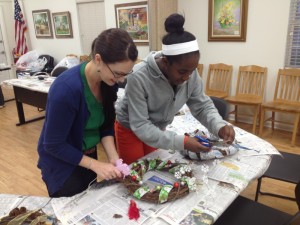
Gulf County adult 4-H Club leader assists a 4-Her on the finishing
touches of her grapevine wreath.
The Gulf County 4-H Craft Club members recently made their own grapevine wreaths and decorated them in their own creative ways.
Materials:
- vine
- pruners
- ribbon and a variety of decorating supplies (pinecones, twigs, leaves, glitter, character cut-outs, floral decorations, miniature birds, etc.)
- hot glue and glue gun
- pipe cleaners (to make a hook for hanging)
Directions:
1. Be sure to begin by finding a large location that can get dirty. The vines drop lots of debris. Find an abundance of firm, but bendable grape vines, gathering and untangling the vine pieces. When they have been tamed into a bundle (thickness is based on individual preference) that is manageable, form the vine into a circular shape on a large surface. Using a few thick strands of vine, begin to wind around the bundle, tucking the end of the vine in. (Note: if natural vines are not available, premade wreaths may be purchased at any craft store at a minimal cost.)
2. Continue to wind and secure the entire wreath. When the end meets the beginning, knit the vine ends together and continue to wind the outer vines to secure, overlapping the starting point. Tuck in any loose ends.
3. Set the wreath somewhere to dry and take shape. Preferably in a warm, sunny location. They will dry much faster this way. (If the kids will be making their own vine wreaths, and not using a pre-purchased one from a craft store, the wreath will need to be made days ahead of the decorating to give it time to dry properly.)
4. Now, it’s time to decorate. Let the kids be imaginative and create their own unique wreath to match their likes and personality. They can experiment by placing the items in different locations on the wreath. Once their decorating decisions are made use the hot glue to secure the items, ribbons, etc.
5. Do not forget to form a loop with a short piece of pipe cleaner to make a hook on the back of the wreath to hang it from.
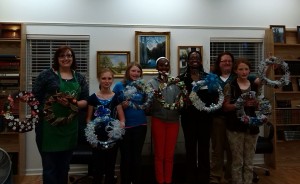
4-H Club members showcase their grapevine wreaths
Now, the wreaths can be taken home and enjoyed by all. Be sure to remember that time spent in nature is calming and refreshing to the human mind. So, as the weather becomes more tolerable here in Florida be sure to take time for yourself and to show youth the importance of natural exploration and creativity.
by jgl1 | Nov 8, 2013
John G. Lilly
jgl@ufl.edu
Jefferson County Extension Director/4-H Agent
Young people in 4-H are committed to improving their communities. Dr. Richard Lerner, and the team at the Institute for Applied Research in Youth Development at Tufts University highlights a notable trend. 4-H youth are three times more likely to actively contribute to their communities when compared with youth who do not participate in 4-H. (more…)
by Julie Pigott Dillard | Nov 8, 2013
All of you 4-H members with fall herb gardens: Would you be willing to sacrifice your apiaceous herbs to the Black Swallowtail Caterpillar?
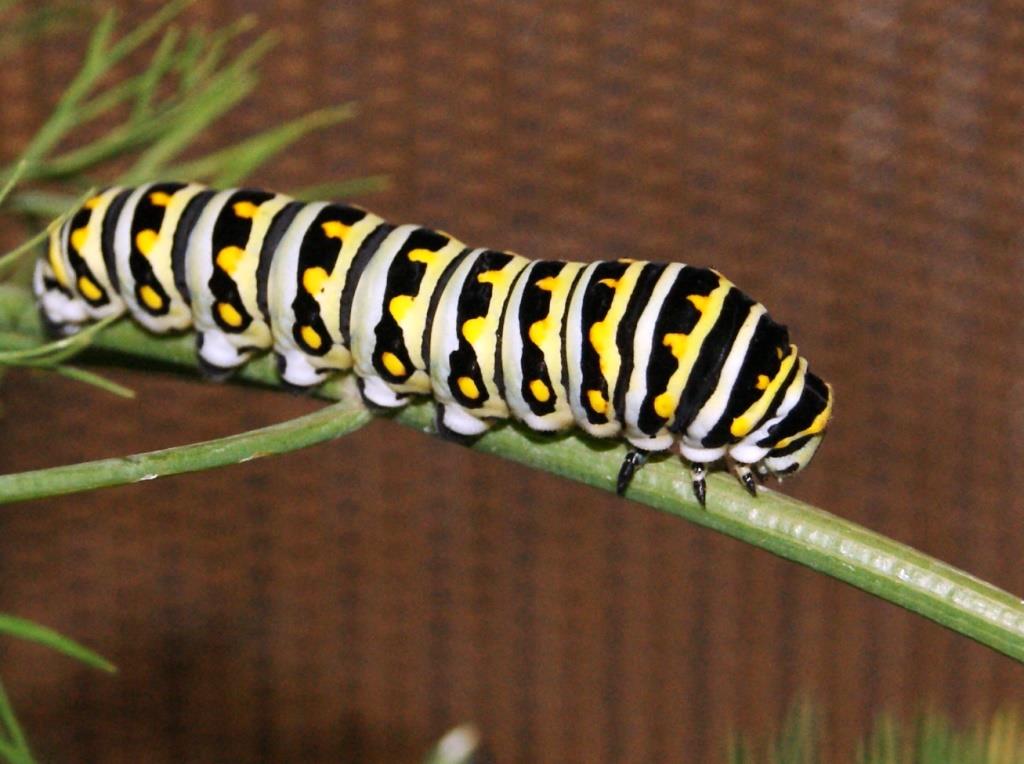
Busily devouring dill and fennel, the lime green, black striped caterpillars in the UF IFAS Extension Washington County Office have quickly become a popular attraction. It is fortunate that the South’s climate is warm enough to allow for three generations of this species every year.
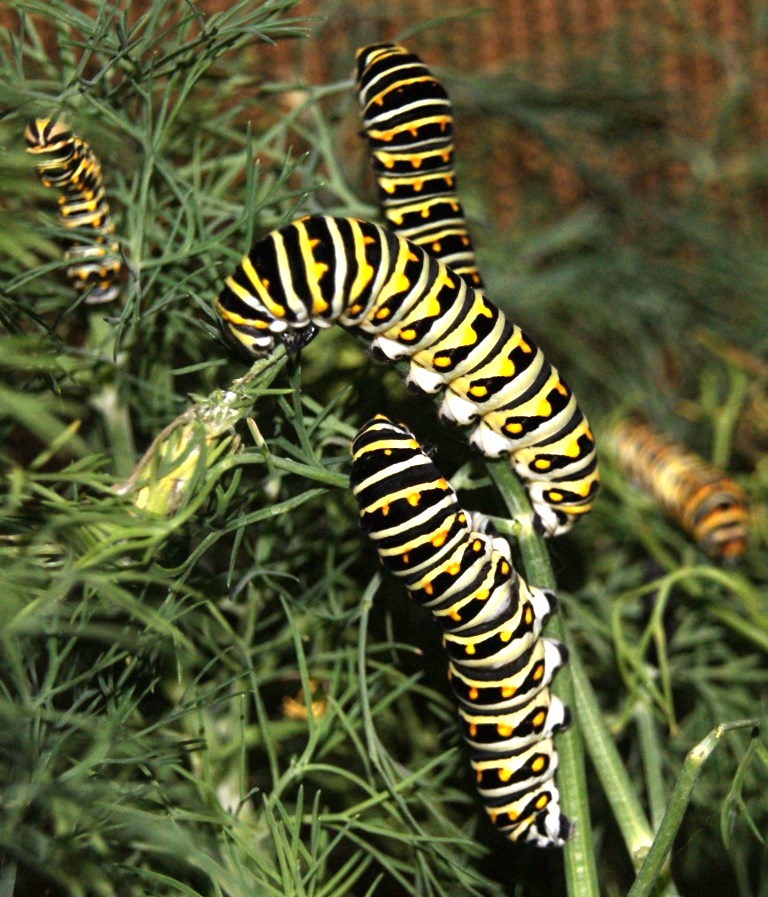
Soon, the caterpillars of the Black Swallowtail (Papilio polyxenes asterius ) butterfly species will continue their pupae stage by forming a chrysalis and emerging as one of Florida’s most recognized swallowtail butterflies.
The chrysalis is formed by two glands located inside the caterpillar that secrete silk. The silk threads stick together and harden when exposed to fresh air. The hard, protective coating is usually camouflaged from predators and blends in with the environment. Inside the chrysalis, the process of metamorphosis continues as the adult structure forms while the juvenile structure breaks down. The insects are very inactive during this time as they grow and change. This stage can last from two weeks to an entire season in temperate climates and tropical dry seasons. When hormones indicate it’s ready, the butterfly emerges by splitting the chrysalis open either biting its way out or using spit to soften the ends.
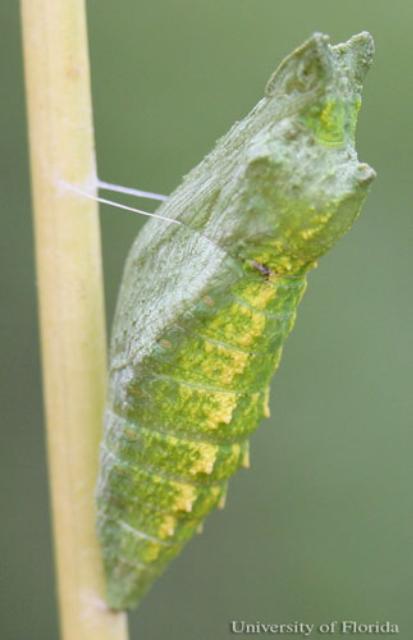
The Black swallowtail has quite a heavy appetite for such a small creature. They eat a variety of plants in the carrot family (Apiaceae) such as dill, fennel, parsley, celery, and carrot leaf. In addition to these cultivated species, they will feast on mock bishopweed, roughfruit scaleseed, spotted water hemlock, water cowbane, and wedgeleaf eryngo. They have also been known to enjoy Common Rue (Ruta graveolens L.).
They exhibit several interesting behaviors throughout their life cycle. For example, when they feel threatened the Black Swallowtail will exhibit yellow antennae-like structures called osmeterium. These flare out and emit a foul odor, like rotten cheese, if one’s finger gets too close.
Even though they are voracious plant eaters and honorable defenders of their territory, butterflies play a vital role in agriculture by pollinating crops and flowers. They’re an indicator of a healthy ecosystem; an abundance and diversity of butterfly species illustrate the overall health of an area. With their acute sensitivity to contaminants and toxins, butterfly populations will not be found in polluted areas. Recognized for their beauty, butterfly watching has also become a popular hobby and pastime.
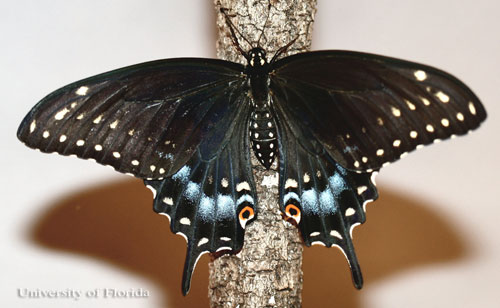
- Photo courtesy of Donald Hall, University of Florida.
It’s never too early to think about planning a butterfly garden. For more information on creating a backyard butterfly habitat, download this 4-H fact sheet for kids and parents. For more information on this specific butterfly, visit the UF IFAS EDIS website for a publication on the Eastern Black Swallwtail.
Additional Content by:
Matthew Orwat, Extension Faculty I, Horticulture, UF IFAS Extension Washington County
by pmdavis | Oct 25, 2013
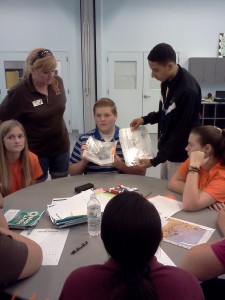
Looking at two different plans designed by group
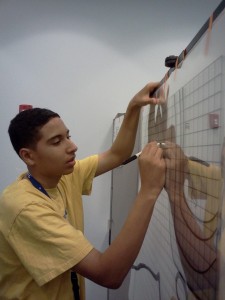
Drawing a map layer
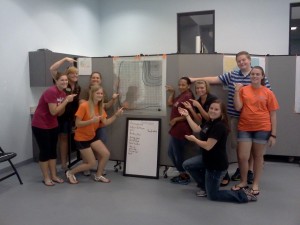
Teens and staff training to teach NYSD Material
October 6-12 was National 4-H Week, and more than 6 million young people across the country celebrated the great things that the 4-H youth development program offers young people and the incredible 4-H’ers who work each day to a make a positive impact on their community.
One of the highlights of National 4-H Week has become the 4-H National Youth Science Day (NYSD). For more than 100 years, 4-H has been at the forefront of teaching young people about science, technology, engineering and math (STEM). Currently, more than five million young people across the nation participate in 4-H STEM programming in topics as varied as robotics, agricultural science, rocketry, wind power, environmental science and alternative energy. NYSD is the premier national rallying event for this year-round 4-H STEM programming, bringing together youth, volunteers, and educators from the nation’s 109 land-grant colleges and universities to simultaneously complete the National Science Experiment.
Wednesday, October 9, 2013, was the official date of the sixth annual 4-H NYSD, and as a part of National 4-H Week, millions of young people became scientists for the day. This event, which takes place in urban, suburban and rural communities all across the nation, seeks to spark an early youth interest and leadership in STEM careers in an effort keep America competitive in those fields.
The 2013 NYSD Experiment is – 4-H Maps & Apps! This set of activities turns young people into geospatial thinkers as they design and map their ideal park, use GIS mapping to solve community problems, and contribute data about their community to the United States Geological Survey.
Research has proven that participation in 4-H has a significant positive impact on young people. Recent findings from the Tufts University 4-H Study of Positive Youth Development indicates that, when compared to their peers, young people in 4-H are:
- Nearly 4 times more likely to contribute to their communities,
- Two times more likely to pursue healthy behaviors, and
- Two times more likely to engage in Science, Technology, Engineering and Math (STEM) programs in the out-of-school time.
National Youth Science Day is just one of the many ways we reach youth to make these kinds of impacts. If you would like more information on 4-H National Youth Science Day or would still like to participate in the activity, there is still time. Information is available at http://www.4-h.org/4-h-national-youth-science-day/. It’s not too late to plan and register your event for 2013!
by Niki Crawson | Oct 11, 2013
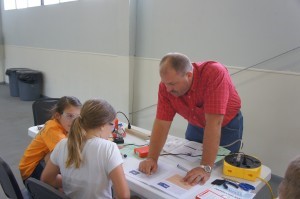
Volunteer teaching local youth how to build underwater robots.
The goal of 4-H is to teach youth life skills. In so doing, we find that we also equip them with marketable skills, a sense of belonging, and a sense of self-worth, each of which makes them more apt to be successful. However, besides the most obvious benefit that your volunteer services are to your local youth and community, there are benefits for you personally as well. In fact, studies indicate that individuals who volunteer, experience greater health benefits,1 and in some cases, that individuals can combat the onset of depression simply by volunteering.2 Additional personal benefits of volunteerism include increased social skills, and an expanded social network.
Another thing to consider is that by volunteering with 4-H you will have the opportunity to make a positive difference in the lives of children. This more than likely will trigger a sense of commitment, pride, and accomplishment in you which leads to a more positive self-image. The more positive your self-image, the more likely you are to set and accomplish positive personal goals, thus feeling a sense of accomplishment which creates a continuous circle of self-worth and confidence.
One of the most undervalued benefits of volunteering with 4-H is the time spent practicing the very life skills you are teaching through 4-H programming like communication, teamwork, and program planning. As you work with your youth to help them develop these life skills, you too are strengthening them in yourself. When they combine their increased life skills with taking part in the wide variety of training opportunities presented through 4-H, some volunteers may open new doors for employment based on the skills they have learned and developed.
In today’s time when families are busier than ever and time seems limited, having a positive adult role model can truly influence the path of youth. Volunteering with a 4-H program allows these positive impacts to occur. If you are already a 4-H volunteer, take pride in your contributions and reap the joy and benefits associated with such. If you are not currently a volunteer, the great news is that you do not have to look far to find a perfect match for your volunteerservices…the Florida 4-H program welcomes you, and area 4-H Agents are eager to help you get started!
1 Dulin and Hill, 2003; Brown et al., 2005; Brown et al., 2003; Liang et al., 2001; Morrow-Howell et al., 2003; Midlarsky and Kahana, 1994; and Schwartz et al., 2003
2 Depression Alliance http://www.depressionalliance.org/latest-news/volunteering-combats-depression.php
by Marcus Boston Jr. | Sep 27, 2013
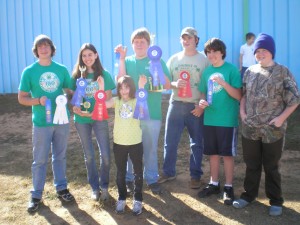
Leon County 4-H youth displaying ribbons at North Florida Fair
The arrival of the fall love bugs, the leaves changing colors and falling to the ground, and the sounds of bands rehearsing and cheerleaders chanting can only mean one thing in North Florida……no it’s not time to shop for Christmas gifts…even though it’s just around the corner, but instead, it means it’s almost FAIR TIME! Fair time is not only viewed as the first official 4-H program kickoff event where most of the club participants can play a part, but it’s also a time where youth take pride in showing off the work they have completed in their clubs.
The fair is a venue for 4-H youth to put their 4-H work on display and in many cases receive premium money based on the quality of their entries. The fair also provides opportunities for competitive events to take place and for some youth to showcase their animals they have worked with and cared for during the past year.
Can a youth’s participation in the fair help to development them into a responsible adult? The answer is yes! The 4-H program seeks to be inclusive to all youth by using a variety of vehicles to teach youth life skills in traditional and non-traditional settings. The vehicles used with fairs could be exhibits, animals, competitions, booths, and the list goes on and on. A recent article in The Journal of Extension by Oregon State professionals found that “having fun” and“ spending time with friends” and “teamwork” were the highest rated motivators for participation in the fair. 
The study also revealed that participation in fairs through 4-H had a significant positive effect on participants levels of caring, contribution, and character. These characteristics are also part of the Essential Elements of 4-H that youth experience by being in an active 4-H program throughout the year. Those elements are Belonging, Independence, Generosity, and Mastery.
These results support the conclusion that participation in county 4-H fairs do contribute to the positive development of youth. Research shows that people as a whole learn more when they are having fun and the activities and events at fairs or no exception. By setting “fair” goals that are not tied to premium money but instead to the warm fuzzies felt by youth when they feel they have contributed to a worthwhile event is the right recipe that’s sure to earn them a blue ribbon for life. So, make plans to utilize the events in your local or regional fairs to help teach your youth life skills. If you choose project entries, and need additional help getting those submitted, please contact your local 4-H agent and request a copy of the Document entitled “Getting 4-H Exhibits Ready For The Fair”.
More information on this study can be obtained by visiting the Journal of Extension at www.joe.org and viewing volume 45, number 6.(Arnold, Meinhold, Skubinna, and Asthton)
by Heather Kent | Sep 18, 2013
LEGOLAND is sponsoring the 1st Annual 4-H Day at LEGOLAND on Saturday, September 28th– just in time for 4-H Club Kickoffs! Florida 4-H Families will be able to purchase tickets to LEGOLAND theme park for $30.00 each (regular price is $75.00). In addition, $5.00 from every ticket sold will go to the Florida 4-H Foundation to support 4-H Clubs and Educational Events.
Order up to 20 tickets in one transaction at: https://secure4.gatewayticketing.com/LegolandFlorida/shop/ViewItems.aspx?CG=4h&C=4h . Tickets are good for both youth and adults. For an additional $15.00/person, you can upgrade your ticket at the gate to include access to the water park. Upon arrival, youth can sign up for free robotics workshops to learn about WeDo, Mindstorms, and the new EV3 robotics kits.
LEGOLAND is a theme park with rides, a water park, educational exhibits, Florida Department of Agriculture Greenhouse, Botanical Gardens and much more. To learn more about LEGOLAND, visit their website at: http://florida.legoland.com/. For questions, please contact Annie Muscato, afmuscato@ufl.edu or Heather Kent hckent@ufl.edu.
by Heather Kent | Sep 17, 2013
Last night, Dr. Paula Davis taught us how we can make a difference by empowering youth to plan and lead effective club meetings. We even practiced parliamentary procedure by making trail mix. Whitney Cherry explained proper 4-H emblem usage and how to secure permission to use the 4-H name and emblem for your club.
All of the games and reference materials are available from our website at: https://nwdistrict.ifas.ufl.edu/4hn/category/volunteer-training/make-a-difference-mondays/. The door prize winner for August was Edward Owen from Walton County. He won a 4-H Club Kit, containing everything you need to run a club meeting. September winners will be announced next week.
Due to feedback from volunteers like you, we have adjusted our training schedule so that the next session, October 21st, will be on Risk Management. 4-H Specialist Dr. Dale Pracht will be sharing valuable best practices for creating safe and secure environments for 4-H club meetings and events. Please invite any 4-H teens, parents or volunteers that you feel would benefit from this session!
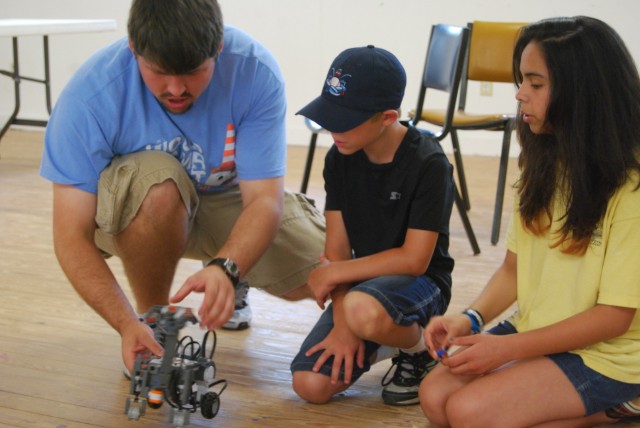 When volunteers share their skills and expertise with youth during 4-H club meetings, youth learn valuable life and leadership skills.
When volunteers share their skills and expertise with youth during 4-H club meetings, youth learn valuable life and leadership skills.
Volunteers like you help 4-H make a difference in over 300,000 Florida 4-H youth each year!
by Whitney Cherry | Sep 16, 2013
Our first session of Make a Difference Mondays was a huge success, and we are very excited to see each of you tonight for round two. If you were not able to join us last month, you are still welcome to attend tonight. We would love to have you!
The session will be offered at your local UF/IFAS Extension Office, or you can join us online from home at 6:00 PM CDT/7:00 PM EDT. Don’t forget to sign in, so we can enter you in the drawing for tonight’s door prizes. Additionally, each time you attend a session of Make a Difference Mondays and sign the sign in sheet (there is one available for online participants as well) your name will be entered in the grand prize drawings to be held in April.
Thank you all again for helping us to “Make the Best Better”!
For more information on how to join the conference online visit: https://nwdistrict.ifas.ufl.edu/4hn/make-a-difference-mondays/
by Stefanie Prevatt | Sep 13, 2013
Welcome to the new 4-H year! As you begin making plans to re-connect with your club members and families, make plans to create a year-long plan for your 4-H Club.
Why should your 4-H club plan up to a year in advance?
A plan will help to:
- Meet the needs of all members
- Share responsibilities (among youth, parents, and volunteers)
- Provide better communication to members and families
- Practice cooperation, compromise, and planning skills
- Avoid calendar conflicts
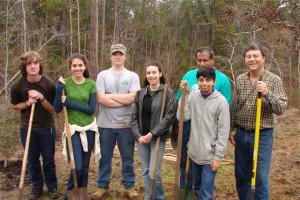
4-H members plant trees for a community service project during Arbor Day.
What should be in your 4-H club plan?
- Monthly Business Meetings
- County, District, and State Activities
- Tours and Trips
- Community Service
- Workshops
- Recreation
- Guest Speakers
- Fund Raising
There are many different ways to create a “year plan” for your 4-H club. The following are a few examples of activities that can be done during a meeting to ensure that all members’ thoughts and ideas are expressed. Keep in mind, when beginning to discuss plans for your club’s focus, education should be the top priority (what youth want to learn during the year).
Sharing Ideas:
Tape a large piece of paper to the wall. On the paper, write two statements: (1) “This year in _____ 4-H Club, I want to learn…” (2) This year in _____ 4-H Club, I really want to….” As youth arrive, direct their attention to the paper and ask them to complete the statements. At a designated time during the meeting, discuss the responses.
Collages:
Have youth create a collage of his/her “year plan” for the club. Materials needed for this activity are: magazines, newspapers, crayons, markers, scissors, glue, construction paper, etc. You can also do this activity in groups.
Design Your Own Clover
Have each member complete the “Design Your Own Clover.” Members can share one leaf of the clover a designated point during the meeting.
Creating a Program Planning Committee
Now that you have all these ideas from your club members, how do you implement your plan? Form a program planning committee. It is important that this committee be representative of your entire club. Older members are likely to be effective planners, but might leave out needs of younger members. In general, committee members are: vice president, secretary, recreation leader, and an adult. It is also good practice to add two or three members who are not officers. This committee can meet on a separate day from the club meeting or convene before/after a club meeting to complete their responsibilities. Once finalized, the committee should report back to the entire club to receive final approval for their plan.
Club planning is not a cut and dry process. Every club can modify these practices to best suite your members – keeping in mind the reason for creating such a plan is to keep the actions of your club directed toward your goals. Your 4-H Extension Agent is also a great resource during this process. Contact your local agent to receive help in creating a plan or for a list of important dates/deadlines for your local office.
Resources:
http://www.uaex.edu/other_areas/publications/PDF/4HCF1.pdf
http://gallia.osu.edu/adams/topics/4-h-youth-development/making-the-best-4-h-clubs-better-twenty-minutes-at-a-time/Handout%20-%20Design%20Your%20Own%20Clover.pdf
http://florida4h.org/clubs/files/4H%20GCL%2020.PDF














